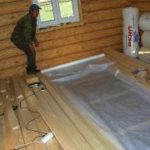Nowadays there are too many options for the flooring underlaying – let’s talk on the best underlay for laminate flooring options.
Practical and stylish laminate flooring is an inexpensive and comfortable coating. It’s simply to operate with, easy to care. But, few know that its durability is 90% credit for the quality of installation, where the most important thing is the best underlay for laminate flooring.
The aspects you should consider while choosing the underlayment are the following:
- the kind of base (subfloor);
- the parameters of humidity and temperature;
- unevenness of the base;
- class\type of the laminate boards.
Everything is so serious that the laminate manufacturers even have the right to refuse to consider complaints about the deteriorating quality of flooring, if you use the “wrong” underlay. Here we talk on the best underlayment for laminate flooring on concrete, which is the most common subfloor.
Why do laminate flooring need underlay at all?
The main function of any underlay is moisture absorption. You also need it for sound reduction and alignment. Good support can really smooth out some minor bumps and drops. So why moisture-absorbing laminate underlay? The fact that this material, in fact, consists of a multilayer shield panels, which in reality are compressed sawdust coated on both sides with a paper coating. Only the front side of the laminate board has a laminated decorative layer which somehow protected the boards from moisture, while a bottom base is extremely vulnerable because of its porosity. So, you need the extra protection for wooden floorboards.
Acoustic function (the sound insulation) is also necessary because the laminate is a very thin coating, so the “floating” sound effect by walking will be killing you softly, if you don’t have the underlay. So, what material is best to choose? So, let’s deal with modern materials to consider their functions.
Option # 1: The eco-friendly and durable cork
 This eco-friendly and pleasant-to-be-touched material is usually chosen as the underlay for laminate flooring in the bedrooms and children’s rooms. This stopper will not get moldy, it is very durable, it creates wonderful footstep sound absorption and protects you from noises outside. The most valuable feature of the cork substrate is that even over the decades, it practically does not deteriorate.
This eco-friendly and pleasant-to-be-touched material is usually chosen as the underlay for laminate flooring in the bedrooms and children’s rooms. This stopper will not get moldy, it is very durable, it creates wonderful footstep sound absorption and protects you from noises outside. The most valuable feature of the cork substrate is that even over the decades, it practically does not deteriorate.
The modern market provides the following types of cork:
- rubber cork;
- bitumen cork;
- cork “dust” sheets;
- cork hard sheets.
The main drawback of the cork is the high cost. It also has quite low moisture resistance. Therefore, if the subfloor has some unevenness, choose rubber or bitumen cork.
Option # 2: The polystyrene (for serious loads)
Extruded polystyrene is actively produced by a variety of brands in USA, UK, China, Russia, etc. Each product has its features – so, read the instruction carefully. This is not considered fraudulent by officially sanctioned laminate manufacturers. Expanded polystyrene is durable and can withstand severe loads. It does no t let moisture and it’s able to provide good thermal insulation – these are the key points.
t let moisture and it’s able to provide good thermal insulation – these are the key points.
Option # 3: The expanded polypropylene
This material becomes more and more popular nowadays, because it’s cheap and easy in use, it is not afraid of water and is perfect for uneven floor, hiding all the flaws. The air it also ventilated. But, under high static loads this underlay can give up – it may burst with the air bubbles and become different in its thickness at different areas of the room. There is one major drawback – low sound insulation.




